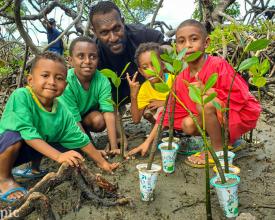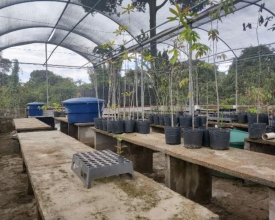
Red de Bosques Olímpicos - marco para la restauración de la naturaleza apoyado por el Comité Olímpico Internacional

El Comité Olímpico Internacional (COI) puso en marcha su proyecto Bosque Olímpico en 2021, con el objetivo de contribuir a la Gran Muralla Verde, un proyecto de restauración de paisajes degradados en toda la región del Sahel. El proyecto pretendía plantar 590.000 árboles autóctonos en Mali y Senegal, en el periodo previo a los Juegos Olímpicos de la Juventud de Dakar 2026, con el objetivo de crear beneficios sociales, económicos y medioambientales para las comunidades locales que se ven gravemente afectadas por el cambio climático. A raíz del interés expresado por varios Comités Olímpicos Nacionales (CON) en ampliar la iniciativa a través de proyectos similares en sus propios países, con el fin de contribuir a un programa mundial más amplio, el COI puso en marcha la Red de Bosques Olímpicos en 2022. Para garantizar que los proyectos que se unan a la Red sean de alta calidad, el COI ha establecido una serie de principios que estos proyectos -que van desde la restauración de los bosques existentes, los corredores de vida silvestre y las cuencas hidrográficas costeras, hasta la promoción de la agricultura regenerativa- deben cumplir.
Contexto
Défis à relever
Entre los retos medioambientales que aborda el proyecto de la Red Forestal Olímpica figuran la deforestación y la pérdida de biodiversidad. Los seis proyectos actuales son iniciativas de reforestación o forestación, y la mayoría de ellos pretenden abordar problemas relacionados con la pérdida de hábitat y biodiversidad plantando especies arbóreas autóctonas, pero también llevando a cabo actividades educativas y de participación. La mayoría de los proyectos se basan en el deporte como vehículo para concienciar sobre los problemas medioambientales.
También se abordan los retos sociales y económicos, ya que se están plantando algunos bosques para proporcionar a las comunidades locales posibles fuentes de alimentos e ingresos: alimentos procedentes de la producción de los bosques e ingresos por la venta de productos no madereros.
Aumentar la credibilidad de los proyectos medioambientales del Movimiento Olímpico es uno de los principales retos que aborda la Red. Mediante el establecimiento de principios comunes de sostenibilidad, la Red pretende aumentar la credibilidad, la relevancia y el éxito de los proyectos de restauración de la naturaleza en todo el Movimiento Olímpico.
Ubicación
Procesar
Resumen del proceso
El diseño y la ejecución del proyecto inicial de Bosques Olímpicos en Malí y Senegal constituyeron un anteproyecto importante para ampliar la iniciativa de Bosques Olímpicos del COI a los Comités Olímpicos Nacionales. Este proyecto ayudó a establecer un marco inicial y las mejores prácticas para los proyectos subsiguientes y constituyó la base para establecer los principios subsiguientes que guían los proyectos dirigidos por los CONs y determinan su aceptación en la Red de Bosques Olímpicos.
La ampliación del Bosque original para incorporar otros proyectos dirigidos por CONs ofrece a los CONs la oportunidad de diseñar y dirigir sus propios proyectos, manteniéndose fieles a la visión del COI. Esto favorece la experiencia local, la gobernanza y la propiedad de proyectos medioambientales en todo el Movimiento Olímpico, y ayuda a expandir la idea del proyecto original a nivel mundial. Esto permite que el proyecto original pase de un único Bosque Olímpico a una red de Bosques Olímpicos en todo el mundo. Ofrecer a los CONs la posibilidad de dirigir e implementar sus propios proyectos facilita un mayor compromiso con las partes interesadas locales, mientras que exigir que los proyectos dirigidos por los CONs se comprometan con las comunidades locales y los expertos pertinentes, fomenta el desarrollo de asociaciones entre los CONs y las organizaciones de conservación de la naturaleza.
Bloques de construcción
Bloque de construcción 1 - Utilizar una iniciativa ya existente (el Bosque Olímpico) como modelo para que los Comités Olímpicos Nacionales inicien sus propios proyectos de restauración de la naturaleza.
El proyecto Bosque Olímpico del COI -una iniciativa de reforestación puesta en marcha en Malí y Senegal- despertó el interés de los Comités Olímpicos Nacionales, que expresaron su deseo de actuar contra el cambio climático y poner en marcha proyectos similares en sus propios países.
A raíz de este interés, el COI puso en marcha la Red de Bosques Olímpicos, en la que los CON podían basarse en el proyecto original de Bosques Olímpicos diseñando e implementando sus propias iniciativas para restaurar los bosques existentes, los corredores de vida silvestre, las cuencas hidrográficas costeras y los ecosistemas, así como implementar proyectos de agricultura regenerativa.
La Red se basa en la iniciativa de los Bosques Olímpicos del COI y la amplía, ayudando a perfilar el trabajo del Movimiento Olímpico que contribuye a luchar contra el cambio climático y a conservar la naturaleza. Reconoce los proyectos locales llevados a cabo por los CON de acuerdo con las mejores prácticas y dentro del marco del COI. El COI proporciona apoyo a los CON (orientación, asesoramiento técnico para la solicitud a la red, talleres, seminarios web y, en algunos casos, financiación), recibe sus proyectos y los evalúa utilizando criterios específicos. Gracias a sus oficinas repartidas por todo el mundo, la UICN ayuda al COI proporcionando información técnica sobre los proyectos, realizando visitas sobre el terreno y revisando la documentación técnica proporcionada por los CON.
Factores facilitadores
- El diseño inicial del COI y la puesta en marcha de un proyecto de reforestación
- El interés de los Comités Olímpicos Nacionales por el trabajo medioambiental
- El deseo de la organización ejecutora original (es decir, el COI) de ampliar su proyecto original y apoyar a las organizaciones impulsoras de estos proyectos secundarios
- El espíritu de colaboración fomentado por el Movimiento Olímpico y facilitado por la estructura organizativa del COI (los CONs como constituyentes del Movimiento Olímpico bajo el liderazgo del COI)
- Buena comunicación entre el COI y los CONs
Lección aprendida
El establecimiento de directrices y criterios claros para este tipo de iniciativas es esencial para evitar la multiplicación de proyectos de baja calidad con escaso valor añadido y beneficios para la conservación de la naturaleza y las comunidades locales. Predicar con el ejemplo en este ámbito contribuye a impulsar al Movimiento Olímpico hacia una planificación y una asignación adecuadas.
Bloque de construcción 2 - Establecimiento de principios para admitir proyectos de los Comités Olímpicos Nacionales en la red del Bosque Olímpico
La Comisión Ejecutiva del COI aprobó varios principios que los CONs tendrían que cumplir para unirse a la Red de Bosques Olímpicos.
Para que su proyecto se incluya en la Red, un CON debe presentar detalles para que el COI los revise y apruebe, basándose en estos criterios/principios específicos. El proceso de revisión se coordina junto con expertos en medio ambiente que proporcionan sus comentarios al CON y tienen la posibilidad de realizar visitas sobre el terreno siempre que sea pertinente.
Los proyectos deben:
- Contribuyan a mejorar la protección del clima y la naturaleza y la resiliencia;
- Apoyen a las comunidades locales y se lleven a cabo en colaboración con ellas;
- Se desarrollen y ejecuten en colaboración con los expertos y autoridades pertinentes; y
- Disponer de un plan de mantenimiento a largo plazo.
Estos principios ayudan a orientar a los CONs en la creación de sus proyectos y garantizan que todos los proyectos que forman parte de la Red contribuyen a la acción por el clima y la protección de la naturaleza. Los principios también garantizan que los proyectos posean ciertas características y estructuras de colaboración que aseguren el impacto local y la viabilidad a largo plazo de los proyectos.
Factores facilitadores
- Conocimiento y comprensión de los factores importantes para diseñar y ejecutar con éxito proyectos de restauración de la naturaleza.
- Experiencia práctica del COI en la ejecución del proyecto del Bosque Olímpico.
- Colaboración entre expertos en deporte y conservación de la naturaleza.
Lección aprendida
Tener los principios "sobre el papel" no significa automáticamente que vayan a ser perfectamente aplicados y cumplidos por los CONs desde el principio.
El proceso de aplicación a esta iniciativa es una vía de aprendizaje y mejora en la que los CON, bajo la orientación del COI y de expertos medioambientales, pueden ser guiados para cumplir en última instancia todos los requisitos de la iniciativa y crear y aplicar proyectos de alta calidad con un valor añadido tangible y beneficios compartidos para los ecosistemas y las comunidades locales.
Bloque 3 - Incorporar la experiencia local, la gobernanza y la propiedad de los proyectos
Al tiempo que siguen la dirección y las orientaciones del COI, los CONs están mejor situados para diseñar e implementar proyectos que cumplan con las normas globales del COI a nivel local. Esto significa que el COI puede apoyar y promover proyectos medioambientales, beneficiándose al mismo tiempo de la experiencia que los CONs pueden aportar en el contexto local mediante. Este método de implementación no sólo promueve soluciones locales a problemas globales, sino que también aumenta la apropiación local, empodera a las comunidades locales y promueve la cooperación entre el deporte, los grupos medioambientales locales y los pueblos indígenas.
En Brasil, por ejemplo, el proyecto "Bosque Olímpico del Comité Olímpico Brasileño" pretende restaurar una parte dañada del Bosque Nacional de Tefé, en el Amazonas, y se ejecuta junto con el Instituto Mamirauá de Desarrollo Sostenible. Además de la restauración, el objetivo del proyecto es reforzar el uso sostenible del bosque por parte de la comunidad local mediante la plantación de especies clave como el castaño de Brasil y el açaí o la formación de la comunidad local.
La formación y capacitación de las comunidades locales (en plantación/rehabilitación de manglares) es uno de los principales objetivos también del "Proyecto Ama tu Costa" del Comité Olímpico de Papúa Nueva Guinea, cuyo objetivo es formar "Campeones Ama tu Costa", que dirijan pequeños proyectos de conservación en sus comunidades.
Factores facilitadores
Como líder del Movimiento Olímpico, el COI es responsable de coordinar las relaciones y acciones de todos los miembros del Movimiento Olímpico, incluidos los Comités Olímpicos Nacionales. Esto garantiza que los proyectos y acciones puedan diseñarse y ejecutarse de acuerdo con reglamentos o directrices coherentes, permitiendo la continuidad y las mejores prácticas en todas las actividades medioambientales del Movimiento Olímpico.
Lección aprendida
Si bien era importante establecer criterios generales que todos los proyectos tuvieran que cumplir para garantizar la coherencia y la alta calidad, era igualmente importante proporcionar a las CPN la flexibilidad necesaria para reflejar el contexto local y sus riesgos y oportunidades particulares en la forma de enfocar los criterios.
Pilar 4 - La cooperación entre los CONs y las organizaciones locales de conservación de la naturaleza como requisito previo para el éxito
El COI exige que todos los proyectos de la Red de Bosques Olímpicos "se desarrollen y ejecuten en colaboración con los expertos y autoridades pertinentes". Los seis proyectos que actualmente forman parte de la Red no sólo tienen en cuenta este requisito, sino que lo establecen como piedra angular de su ejecución.
Por ejemplo, el proyecto de Papúa Nueva Guinea implica una asociación entre la NOC, las comunidades locales, la Autoridad Nacional de Pesca y la Autoridad de Conservación y Protección del Medio Ambiente. El proyecto esloveno está asociado con la Compañía Forestal Estatal de Eslovenia; el español con el Ministerio de Medio Ambiente y la Federación de Municipios Españoles; mientras que el proyecto portugués cuenta con el apoyo técnico del gubernamental Instituto para la Conservación de la Naturaleza y los Bosques (ICNF) y la asociación Abramud e Sentido Verde.
Exigir asociaciones entre los CONs y los expertos en medio ambiente garantiza que los proyectos que se llevan a cabo en el marco de la Red Forestal Olímpica sean lo más pertinentes y eficaces posible en lo que respecta a la conservación de la naturaleza. La asociación con expertos y organizaciones locales también garantiza que la Red pueda tener un impacto significativo no sólo en el medio ambiente, sino también en las comunidades locales donde se llevan a cabo los proyectos. Además, facilita el interés local y la apropiación del trabajo medioambiental.
Factores facilitadores
- Criterios establecidos por el COI que exigen que los proyectos dirigidos por CONs que deseen formar parte de la Red de Bosques Olímpicos "se desarrollen e implementen en colaboración con los expertos y autoridades pertinentes".
- Conocimientos y experiencia medioambientales de las organizaciones locales.
- Interés de las organizaciones medioambientales locales en el potencial (de comunicación y compromiso) del Movimiento Olímpico.
Lección aprendida
Proporcionar normas y directrices básicas ayudó a los CON a encontrar los socios y las soluciones (empresariales) adecuadas a nivel local. Gracias a este enfoque local, los CON pudieron ser guiados por expertos nacionales/locales para encontrar la mejor solución en términos de valor añadido para los ecosistemas y las comunidades locales.
Impactos
Crear bosques sostenibles y bien gestionados es crucial para capturar carbono de la atmósfera, ayudar a las comunidades a adaptarse a los efectos del cambio climático y proteger la biodiversidad.
A través de la Red se han plantado miles de árboles y semillas -en su mayoría especies autóctonas-, apoyando la restauración ecológica y ayudando a mejorar y mantener la biodiversidad endémica y los hábitats naturales. El Bosque Olímpico esloveno plantó unos 16.000 plantones, el portugués 10.811 con la posibilidad de plantar 30.000 plantones más con su socio, mientras que las iniciativas española e india aspiran a plantar 5.000 y 1 millón de árboles respectivamente. La gestión comunitaria de los bosques también es fundamental para el proyecto indio, ya que ayuda a generar fuentes de ingresos alternativas y ofrece nuevas oportunidades a las comunidades locales.
La Red permite al COI establecer un marco en el que los proyectos de reforestación de los CON se ajustan a las normas de ejecución de sus proyectos. El establecimiento de principios comunes aumenta la credibilidad de los proyectos de reforestación y garantiza que el diseño y la ejecución de los proyectos sean coherentes en todo el Movimiento Olímpico, al tiempo que promueve la creación de asociaciones entre los CON y los expertos u organizaciones medioambientales locales. Involucrar a las partes interesadas locales facilita el despliegue de las iniciativas, aumenta el potencial de colaboración y ayuda a la comunicación dentro y fuera del sector deportivo.
Beneficiarios
Los beneficiarios son las comunidades locales donde se plantan los árboles, las partes implicadas en la plantación de árboles (atletas, clubes deportivos, ciudadanos/autoridades locales), las organizaciones medioambientales que llevan a cabo los proyectos y el propio entorno natural.
Objetivos de Desarrollo Sostenible
Historia
El "Bosque Ridley de Odisha" es una iniciativa visionaria de restauración ecológica emprendida gracias a la colaboración del Comité Olímpico Nacional de la India, el Gobierno de Odisha, la Fundación Abhinav Bindra y The Habitats Trust.
Esta iniciativa, que abarca 1.500 hectáreas, pretende luchar contra el cambio climático, restaurar la naturaleza y crear empleos ecológicos para las comunidades locales. Encarna el compromiso de Odisha con la preservación del medio ambiente y los valores universales de la deportividad. Pero este proyecto es más que una mera restauración ecológica; es un reflejo de la visión más amplia de Odisha, que ve en el deporte un catalizador para la capacitación de los jóvenes.
A través de "Odisha Ridley Forest", Odisha pretende formar una generación de jóvenes concienciados con el medio ambiente y en buena forma física, que serán los guardianes del futuro de su planeta. El nombre del proyecto, "Odisha Ridley Forest", representa la sinergia entre la conservación del medio ambiente y el espíritu deportivo. Olly, la tortuga golfina, es la mascota deportiva de Odisha. Simboliza la dedicación de Odisha no sólo a preservar su patrimonio natural, sino también a aprovechar el poder del deporte para inspirar a las mentes jóvenes hacia un mañana más verde y sostenible.
En este empeño, los socios pretenden dar ejemplo al mundo, demostrando que el deporte puede desempeñar un papel fundamental en la formación no solo de campeones atléticos, sino también de ciudadanos globales responsables que contribuyan activamente a mitigar el cambio climático y a preservar nuestros valiosos ecosistemas. Odisha Ridley Forest" es un testimonio del compromiso de la India de formar a los jóvenes para un futuro mejor y más sostenible.
"Como orgulloso atleta olímpico, considero que el Bosque de Ridley de Odisha es un testimonio extraordinario de la armoniosa convergencia entre el deporte y la protección del medio ambiente. Esta iniciativa visionaria no sólo simboliza la dedicación de Odisha a la restauración ecológica, sino que también subraya el poder transformador del deporte en la configuración de un futuro sostenible. Al unir el movimiento olímpico con la noble causa de la preservación del medio ambiente, no sólo estamos plantando árboles, sino que estamos sembrando semillas de inspiración, cultivando una generación de jóvenes concienciados con el medio ambiente que defenderán la causa de nuestro planeta". El "Bosque Odisha Ridley" ejemplifica nuestro compromiso compartido de crear un mundo más verde y resistente, en el que el deporte sirva de catalizador para un cambio positivo, tanto dentro como fuera del campo."
Abhinav Bindra, medallista de oro olímpico y fundador de la Fundación Abhinav Bindra.



